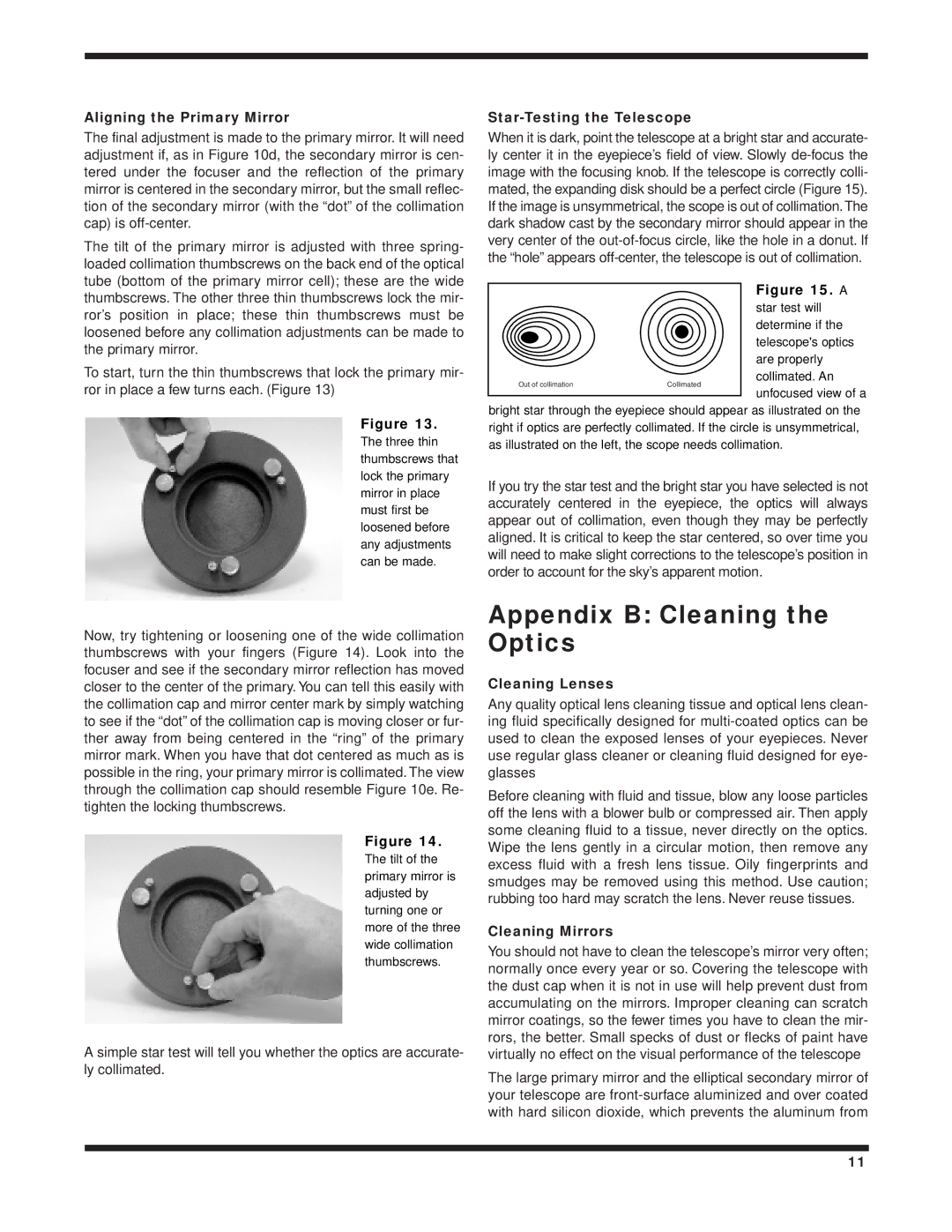
Aligning the Primary Mirror
The final adjustment is made to the primary mirror. It will need adjustment if, as in Figure 10d, the secondary mirror is cen- tered under the focuser and the reflection of the primary mirror is centered in the secondary mirror, but the small reflec- tion of the secondary mirror (with the “dot” of the collimation cap) is
The tilt of the primary mirror is adjusted with three spring- loaded collimation thumbscrews on the back end of the optical tube (bottom of the primary mirror cell); these are the wide thumbscrews. The other three thin thumbscrews lock the mir- ror’s position in place; these thin thumbscrews must be loosened before any collimation adjustments can be made to the primary mirror.
To start, turn the thin thumbscrews that lock the primary mir- ror in place a few turns each. (Figure 13)
Figure 13.
The three thin thumbscrews that lock the primary mirror in place must first be loosened before any adjustments can be made.
Now, try tightening or loosening one of the wide collimation thumbscrews with your fingers (Figure 14). Look into the focuser and see if the secondary mirror reflection has moved closer to the center of the primary. You can tell this easily with the collimation cap and mirror center mark by simply watching to see if the “dot” of the collimation cap is moving closer or fur- ther away from being centered in the “ring” of the primary mirror mark. When you have that dot centered as much as is possible in the ring, your primary mirror is collimated. The view through the collimation cap should resemble Figure 10e. Re- tighten the locking thumbscrews.
Figure 14.
The tilt of the primary mirror is adjusted by turning one or more of the three wide collimation thumbscrews.
A simple star test will tell you whether the optics are accurate- ly collimated.
Star-Testing the Telescope
When it is dark, point the telescope at a bright star and accurate- ly center it in the eyepiece’s field of view. Slowly
Figure 15. A
star test will determine if the telescope's optics are properly collimated. An
Collimated
unfocused view of a
bright star through the eyepiece should appear as illustrated on the right if optics are perfectly collimated. If the circle is unsymmetrical, as illustrated on the left, the scope needs collimation.
If you try the star test and the bright star you have selected is not accurately centered in the eyepiece, the optics will always appear out of collimation, even though they may be perfectly aligned. It is critical to keep the star centered, so over time you will need to make slight corrections to the telescope’s position in order to account for the sky’s apparent motion.
Appendix B: Cleaning the Optics
Cleaning Lenses
Any quality optical lens cleaning tissue and optical lens clean- ing fluid specifically designed for
Before cleaning with fluid and tissue, blow any loose particles off the lens with a blower bulb or compressed air. Then apply some cleaning fluid to a tissue, never directly on the optics. Wipe the lens gently in a circular motion, then remove any excess fluid with a fresh lens tissue. Oily fingerprints and smudges may be removed using this method. Use caution; rubbing too hard may scratch the lens. Never reuse tissues.
Cleaning Mirrors
You should not have to clean the telescope’s mirror very often; normally once every year or so. Covering the telescope with the dust cap when it is not in use will help prevent dust from accumulating on the mirrors. Improper cleaning can scratch mirror coatings, so the fewer times you have to clean the mir- rors, the better. Small specks of dust or flecks of paint have virtually no effect on the visual performance of the telescope
The large primary mirror and the elliptical secondary mirror of your telescope are
11
